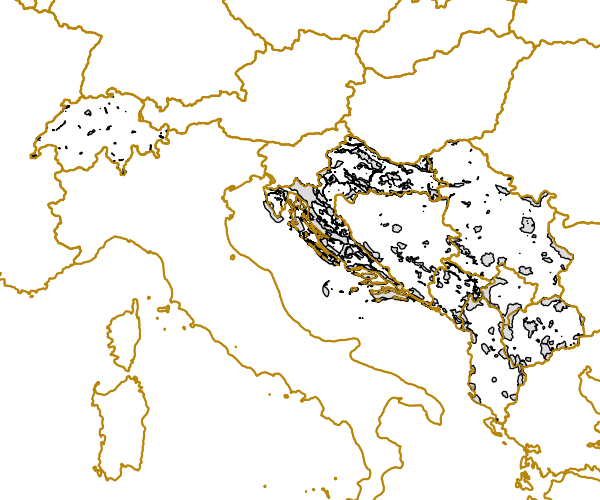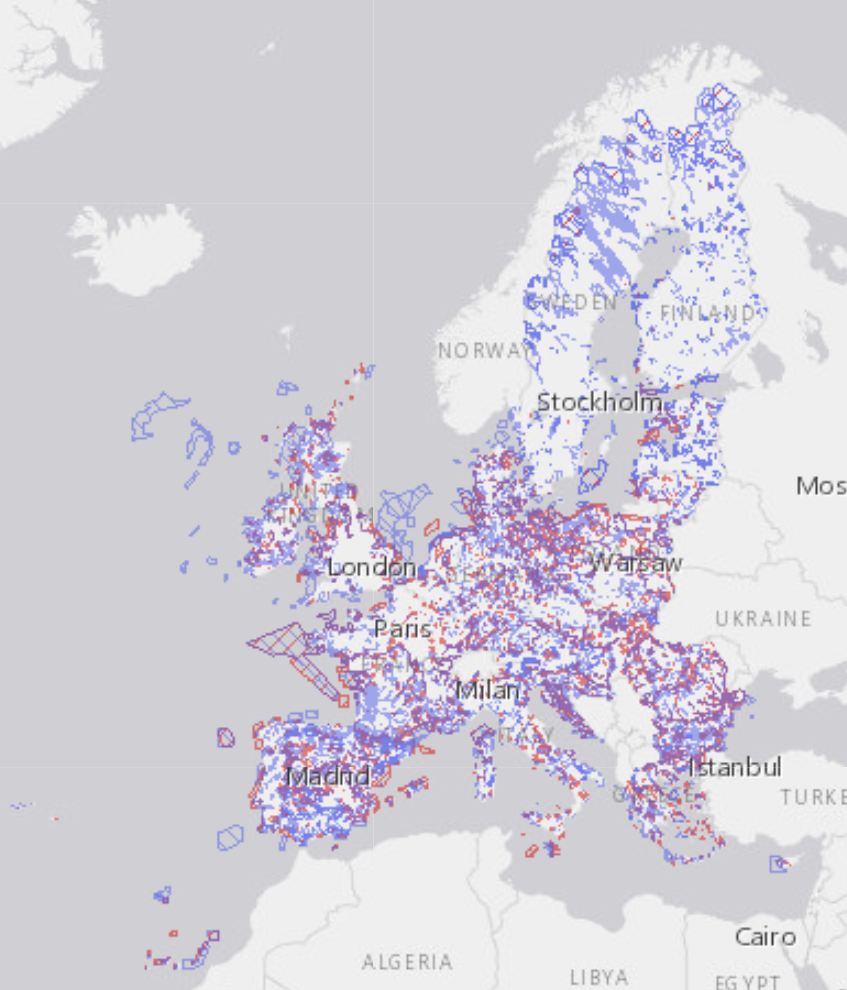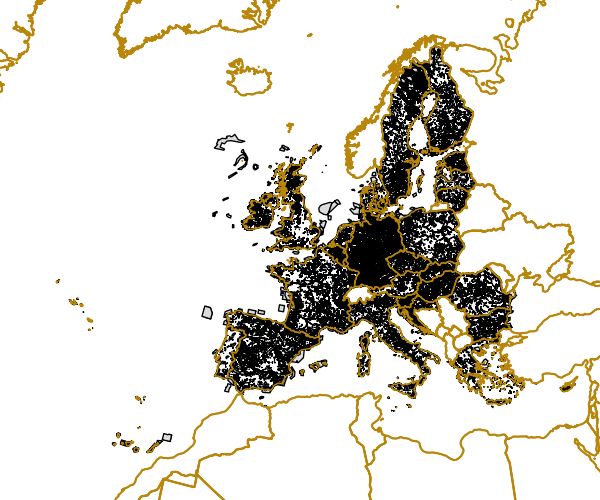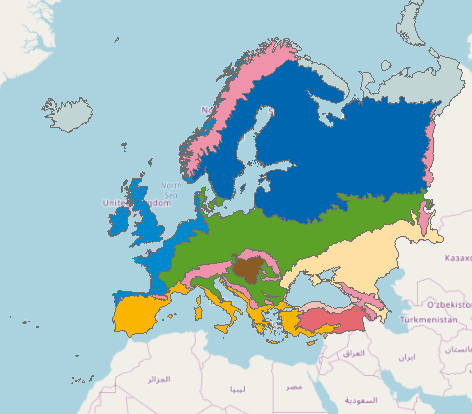IDP_topics_Biodiversity
Type of resources
Available actions
Topics
INSPIRE themes
Keywords
Contact for the resource
Provided by
Years
Formats
Representation types
Update frequencies
status
Scale
Resolution
-

Natura 2000 is an ecological network composed of sites designated under the Birds Directive (Special Protection Areas, SPAs) and the Habitats Directive (Sites of Community Importance, SCIs, and Special Areas of Conservation, SACs). The European database on Natura 2000 sites consists of a compilation of the data submitted by Member States to the European Commission. This European database is generally updated once per year, so as to take into account any updating of the content of the national databases by Member States. However, the release of a new EU-wide database does not necessarily entail that a particular national dataset has recently been updated. The descriptive data in the European database are based on the information that national authorities have submitted, for each of the Natura 2000 sites, through a site-specific standard data form (SDF). Amongst other site-specific information, the standard data form provides the list of all species and habitat types for which a site is officially designated. The spatial data (borders of sites) submitted by each Member State are validated by the European Environment Agency (EEA), including as regard their consistency with the descriptive data. Any problems identified through the above validation procedures in the national datasets are brought to the attention of the Member States concerned. However, it remains up to the Member States to decide whether or not to submit a revised dataset before the European database is updated. As a consequence, the EEA cannot guarantee that all inconsistences detected in national datasets are removed in the European dataset. Please note that some Member States have submitted sensitive information that has been filtered out of this database. The following Member States have submitted sensitive information: Austria, Finland, France, Germany, Ireland, Italy, Latvia, Luxembourg, Poland, Spain and Sweden. This concerns mainly species associated to specific sites. All reference to these species has been removed from the related sites. If this sensitive information is necessary to your field of research, please contact the Member States' administrations individually. You can find a compiled list of national or regional Natura 2000 websites at the following address: http://ec.europa.eu/environment/nature/natura2000/db_gis/index_en.htm#sites There are specific terms and conditions relating to the use of downloaded boundary data within the United Kingdom. If you intend to use the UK data you must first agree to the end user licence http://www.jncc.gov.uk/page-5232.
-

The Emerald Network is a network of Areas of Special Conservation Interest (ASCIs), which is to be established in the territory of the Contracting Parties and Observer States to the Convention on the Conservation of European Wildlife and Natural Habitats (Bern Convention), including Central and Eastern European countries and the EU Member States. For EU Member States, Emerald Network sites are those of Natura 2000.
-

Natura 2000 is the key instrument to protect biodiversity in the European Union. It is an ecological network of protected areas, set up to ensure the survival of Europe's most valuable species and habitats. Natura 2000 is based on the 1979 Birds Directive and the 1992 Habitats Directive. This version covers the reporting in 2019. Natura 2000 is an ecological network composed of sites designated under the Birds Directive (Special Protection Areas or SPAs) and the Habitats Directive (Sites of Community Importance or SCIs, and Special Areas of Conservation or SACs). The European database of Natura 2000 sites consists of a compilation of the data submitted by the Member States of the European Union. This European database is generally updated once a year to take into account any updating of national databases by Member States. However, the release of a new EU-wide database does not necessarily mean that a particular national dataset has recently been updated. The descriptive data in the European database are based on the information that national authorities have submitted, for each of the Natura 2000 sites, through a site-specific standard data form (SDF). In addition to other site-specific information, the standard data form provides the list of all species and habitat types for which a site is officially designated. The spatial data (outlining the boundaries of sites) submitted by each Member State are validated by the European Environment Agency (EEA). Any problems identified through the above validation procedures in the national datasets are brought to the attention of the Member States concerned. However, it remains up to the Member States to decide whether to submit a revised dataset before the European database is updated. The EEA therefore cannot guarantee that all inconsistences detected in national datasets are removed in the European dataset. Please note that some Member States have submitted sensitive information that has been filtered out of this database. The following Member States have submitted sensitive information: Austria, Belgium, Cyprus, Estonia, Finland, France, Germany, Ireland, Italy, Latvia, Lithuania, Luxembourg, Malta, Poland, Portugal, Slovakia, Spain, Sweden and United Kingdom. This concerns mainly species associated to specific sites. All reference to these species has been removed from the related sites. If this sensitive information is necessary to your field of research, please contact the Member State administrations individually. You can find a compiled list of national or regional Natura 2000 websites at the following address: http://ec.europa.eu/environment/nature/natura2000/db_gis/index_en.htm#sites There are specific terms and conditions relating to the use of downloaded boundary data within the United Kingdom. If you intend to use the UK data, you must first agree to the end-user licence http://www.jncc.gov.uk/page-5232. Besides the web service link provided in the metadata, the following services provide information on species and habitat types inside the Natura 2000 sites: https://bio.discomap.eea.europa.eu/arcgis/rest/services/ProtectedSites/Natura2000Habitats/MapServer https://bio.discomap.eea.europa.eu/arcgis/rest/services/ProtectedSites/Natura2000Species/MapServer NOTE: The dataset has been corrected in June 2020 and the files uploaded on the SDI on 30 July 2020. Files downloaded before that date has one invalid site type code (G) that was corrected (to B) in June.
-

Natura 2000 is an ecological network composed of sites designated under the Birds Directive (Special Protection Areas, SPAs) and the Habitats Directive (Sites of Community Importance, SCIs, and Special Areas of Conservation, SACs). The European database on Natura 2000 sites consists of a compilation of the data submitted by Member States to the European Commission. This European database is generally updated once per year, so as to take into account any updating of the content of the national databases by Member States. However, the release of a new EU-wide database does not necessarily entail that a particular national dataset has recently been updated. The descriptive data in the European database are based on the information that national authorities have submitted, for each of the Natura 2000 sites, through a site-specific standard data form (SDF). Amongst other site-specific information, the standard data form provides the list of all species and habitat types for which a site is officially designated. The spatial data (borders of sites) submitted by each Member State are validated by the European Environment Agency (EEA), including as regard their consistency with the descriptive data. Any problems identified through the above validation procedures in the national datasets are brought to the attention of the Member States concerned. However, it remains up to the Member States to decide whether or not to submit a revised dataset before the European database is updated. As a consequence, the EEA cannot guarantee that all inconsistences detected in national datasets are removed in the European dataset. Please note that some Member States have submitted sensitive information that has been filtered out of this database. The following Member States have submitted sensitive information: Austria, Finland, France, Germany, Ireland, Italy, Latvia, Luxembourg, Poland, Spain and Sweden. This concerns mainly species associated to specific sites. All reference to these species has been removed from the related sites. If this sensitive information is necessary to your field of research, please contact the Member States' administrations individually. You can find a compiled list of national or regional Natura 2000 websites at the following address: http://ec.europa.eu/environment/nature/natura2000/db_gis/index_en.htm#sites There are specific terms and conditions relating to the use of downloaded boundary data within the United Kingdom. If you intend to use the UK data you must first agree to the end user licence http://www.jncc.gov.uk/page-5232.
-

Gridded Distribution of Habitats as reported during the Article 17 of the Habitats Directive (92/43/EEC) covering the period 2007 to 2012. The data covers the EU 27 (2007). All Member States are requested by the Habitats Directive (92/43/EEC) to monitor habitat types and species considered to be of Community interest. Article 17 of the Habitats Directive 92/43/EEC requires that every 6 years Member States prepare reports to be sent to the European Commission on the implementation of the Directive. The Article 17 report for the period 2007-2012 includes assessments on the conservation status of the habitat types and species of Community interest. Information on the data quality of the 2007-2012 reporting round is available at http://bd.eionet.europa.eu/article17. The data are available in the table ART17_HD of the database.
-

The data set combines the Corine based MAES (Mapping and Assessment of Ecosystems and their Services) ecosystem classes with the non-spatial EUNIS habitat classification (LEVEL 2) for a better biological characterization of ecosystems across Europe (EEA-39). As such it represents probabilities of EUNIS habitat presence for each MAES ecosystem type. The data set aims to combine spatially explicit land cover information with non-spatially referenced habitat information to improve our knowledge about ecosystems and their distribution across Europe. The work supports the MAES process, Target 2 Action 5 of the implementation of the EU Biodiversity Strategy to 2020, established to achieve the Aichi targets of the Convention of Biological Diversity (CBD). The objective of the ecosystem data set produced by EEA and its Topic Centre ETC/SIA was to improve the biological description of land cover based ecosystem types. It represents probabilities of EUNIS habitat presence in ecosystem types at European level. Since it is not based on spatial explicit mapping the spatial and thematic accuracy is not of same quality as delineated maps. The MAES ecosystem typology differentiates three levels: whereas the level 2 of the MAES proposal follows closely the EUNIS level 1, the third level of the MAES typology corresponds to the EUNIS level 2. This level will be the base for the mapping approach.
-

The European inventory of Nationally designated areas (CDDA) holds information about designated areas and their designation types, which directly or indirectly create protected areas. The inventory is delivered by the Eionet partnership countries as spatial and tabular information. The inventory began in 1995 under the CORINE programme of the European Commission. The CDDA is now an agreed annual Eionet core data flow maintained by the European Environment Agency (EEA) with support from the European Topic Centre on Biological Diversity (ETC/BD). The dataset is used by the EEA and e.g. the UNEP-WCMC for their main European and global assessments, products and services. The CDDA is the official source of protected area information from the 39 European countries to the World Database of Protected Areas (WDPA). The CDDA data can be queried online in the European Nature Information System (EUNIS). This metadata refers to the internal version of the CDDA dataset version 18 (2020). EEA does not have permission to distribute some or all sites reported by Estonia, Finland, Ireland and Turkey. The public version dataset is available with the title "Nationally designated areas (CDDA) for public access - version 18, May 2020", which is derived from this dataset. Two versions of the dataset are provided. The full dataset ("CDDA_2020_v01_internal") includes the entire geographical coverage including nationally designated areas in overseas entities. The "CDDA_2020_v01_internal_EuropeEPSG3035" version includes only continental Europe, i.e. excludes the overseas entities. Both versions are provided in GDB and GPKG formats. The dataset is accompanied by the following tabular data: CDDA_2020_v01_internal_DesignatedArea.csv, which includes information on all the nationally designated sites and designated boundaries; and CDDA_2020_v01_public_DesignationType.csv, which contains information about designation types and the national and international legislative instruments, which directly or indirectly create protected designated areas in Europe.
-

Gridded Distribution of Species as reported during the Article 17 of the Habitats Directive (92/43/EEC) covering the period 2007 to 2012. The data covers the EU 27 (2007). All Member States are requested by the Habitats Directive (92/43/EEC) to monitor habitat types and species considered to be of Community interest. Article 17 of the Habitats Directive 92/43/EEC requires that every 6 years Member States prepare reports to be sent to the European Commission on the implementation of the Directive. The Article 17 report for the period 2007-2012 includes assessments on the conservation status of the habitat types and species of Community interest. This version includes species flagged as sensitive by Member States. Information on the data quality of the 2007-2012 reporting round is available at http://bd.eionet.europa.eu/article17. The data are available in the table ART17_SD of the database.
-

Natura 2000 is an ecological network composed of sites designated under the Birds Directive (Special Protection Areas, SPAs) and the Habitats Directive (Sites of Community Importance, SCIs, and Special Areas of Conservation, SACs). The European database on Natura 2000 sites consists of a compilation of the data submitted by Member States to the European Commission. This European database is generally updated once per year, so as to take into account any updating of the content of the national databases by Member States. However, the release of a new EU-wide database does not necessarily entail that a particular national dataset has recently been updated. The descriptive data in the European database are based on the information that national authorities have submitted, for each of the Natura 2000 sites, through a site-specific standard data form (SDF). Amongst other site-specific information, the standard data form provides the list of all species and habitat types for which a site is officially designated. The spatial data (borders of sites) submitted by each Member State are validated by the European Environment Agency (EEA), including as regard their consistency with the descriptive data. Any problems identified through the above validation procedures in the national datasets are brought to the attention of the Member States concerned. However, it remains up to the Member States to decide whether or not to submit a revised dataset before the European database is updated. As a consequence, the EEA cannot guarantee that all inconsistences detected in national datasets are removed in the European dataset. Please note that some Member States have submitted sensitive information that has been filtered out of this database. The following Member States have submitted sensitive information: Austria, Finland, France, Germany, Ireland, Italy, Latvia, Luxembourg, Poland, Spain and Sweden. This concerns mainly species associated to specific sites. All reference to these species has been removed from the related sites. If this sensitive information is necessary to your field of research, please contact the Member States' administrations individually. You can find a compiled list of national or regional Natura 2000 websites at the following address: http://ec.europa.eu/environment/nature/natura2000/db_gis/index_en.htm#sites There are specific terms and conditions relating to the use of downloaded boundary data within the United Kingdom. If you intend to use the UK data you must first agree to the end user licence http://www.jncc.gov.uk/page-5232. Besides the web service link provided in the metadata, the following services provide information on species and habitat types inside the Natura 2000 sites: https://bio.discomap.eea.europa.eu/arcgis/rest/services/ProtectedSites/Natura2000Habitats/MapServer https://bio.discomap.eea.europa.eu/arcgis/rest/services/ProtectedSites/Natura2000Species/MapServer
-

The biogeographical regions dataset contains the official delineations used in the Habitats Directive (92/43/EEC) and for the EMERALD Network set up under the Convention on the Conservation of European Wildlife and Natural Habitats (Bern Convention). The Pannonian region of Serbia was missing in previous versions and this has been corrected in the 2016 version. Some Arctic islands which do not belong to the European part of Russia and which were erroneously included in previous versions have been removed.
 RUC Geo-Data catalogue
RUC Geo-Data catalogue